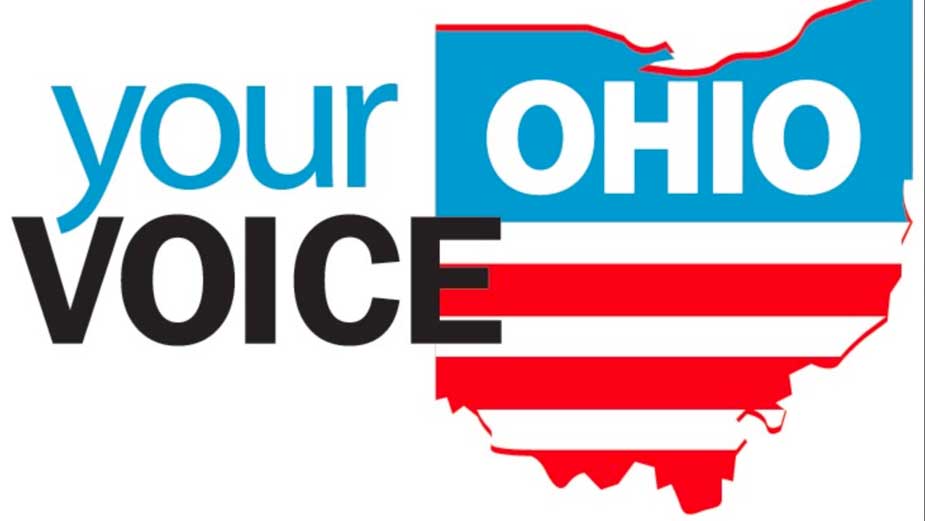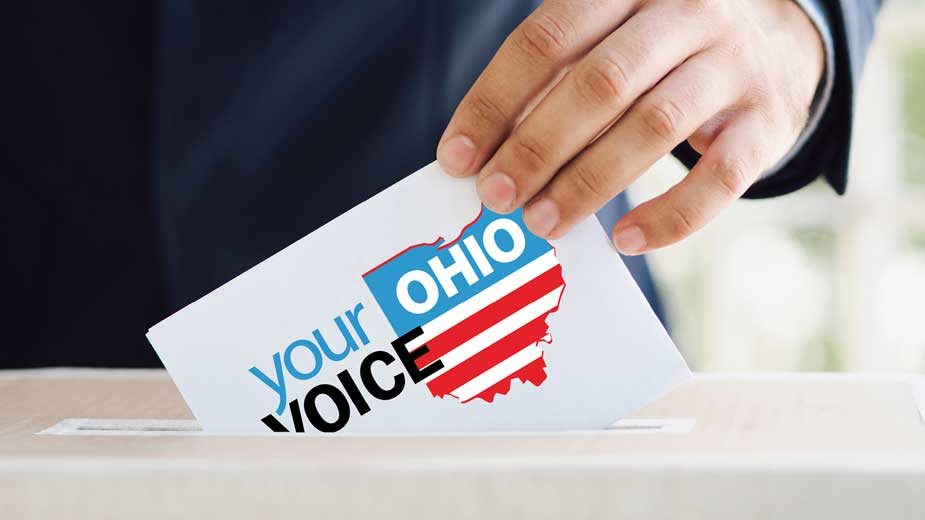Ohio Journalists Examine Their Role in Divisiveness, Serving Community
It was a steamy July week in Ohio as folks from around the state sat in front of computers and smartphones for two-hour online conversations.
The purpose of the sessions was so reporters and editors in the Your Voice Ohio media project could hear and better represent what was on people’s minds as the presidential election loomed less than four months away. But it was an awakening for those journalists, who are steeped in politics and acutely tuned to the news. Ohioans had more pressing issues than an election.
People quickly veered from pointed questions about voting to discuss the angst caused by a pandemic and racial unrest, both of which were drawing angry Americans into the streets.
Repeated often were words such as deaths, virus, jobs, fake, police and race. And at the heart of their agitation was another oft-repeated word: media. “Media sells conflict,” one participant said.
Older generations complained that Facebook had supplanted traditional media as the trading place for information. Younger participants who wanted to vote couldn’t find mediated and meaningful information about candidates.
And, a common refrain was, “Where’s Walter?”
Not, “Where’s Waldo?” but “Where’s Walter?”
A thirst for Walter
Building relationships and restoring trust in media is the reason the Your Voice Ohio media collaborative exists. In the last five years, hundreds of reporters, editors and news directors have sat with well over 1,000 Ohioans to discuss elections, the opioid crisis and how to revitalize communities.
In those conversations, people often shared instructive perceptions of the news media’s role in the country’s divisive politics and growing distrust in institutions — and journalists have thought about ways to change.
“I feel we have lost the sparkle in the world,” said a young father in suburban Toledo as he discussed the July rush of distressing news.
“I’m tired of media bias,” said a Toledo area woman who did not want her name used. People participated with an agreement of anonymity so that they could share personal experiences and feelings. Many, nonetheless agreed to be named.
“I want to hear all the facts,” she said. “I think you can be dishonest by communicating the facts but not all of them. And by the way, where’s Walter Cronkite when you need him?”
She was among several Ohioans over the age of 50 who recalled the days of just three television networks, each with its own evening news, and wished for the deep, gravelly voice of Cronkite, who finished each program with a conclusive, “And that’s the way it is.”
In a 1973 national poll, the CBS anchorman was named the most trusted person in America.
Today, people have access to information from dozens of sources, many of them playing to people of one frame of mind as opposed to Cronkite’s news summaries that attempted to play no favorites. According to a Pew Research Center study, conservatives and liberals, Republicans and Democrats, have different sources of information and do not trust the other.
That has resulted in competing messages.
Stephen Madonna, a Medina County retiree in a September Your Voice Ohio conversation, said integrity is missing from the news. “It’s no longer the facts. When you listened to Walter Cronkite you had the news. I don’t know what the truth is anymore.”
Your Voice Ohio does its work by bringing local journalists and people together to discuss issues at the personal level and, through dialogue, common ground often emerges. The result is recognition by journalists that the divisiveness they cover in government and politics is not reflective of how Ohioans are most likely to act. Moreover, issues important to daily life are often different from what emanates from institutional coverage.
From July through October, Your Voice Ohio conducted four rounds of dialogues – each round divided into five sessions, one for each region of the state. The sessions were designed and facilitated by Kyle Bozentko and Sarah Atwood of the Jefferson Center for New Democratic Processes, a 50-year-old non-partisan civic engagement and research organization which manages the Your Voice Ohio collaborative.
Reporters watched as people with diametrically opposing opinions listened to one another and built on ideas on which they agreed or, sometimes, even changed their minds. Almost all Your Voice Ohio participants — selected to provide political and demographic diversity — said they enjoyed conversations with people unlike themselves and would be willing to do it again.
Conflict is a turn-off
Paulette Gunn of suburban Toledo directed her anger at television. “Something has to be done about the news broadcasts we’re getting,” she said. “It used to be there were very good journalists, good reporters. You knew the facts, then you could make up your mind. You knew where to go [for that]. You didn’t have all this slanting. It’s like the whole world is lying to you. I don’t know what can be taken, maybe legal action against them if they’re lying.”
It was not unusual for some to say they stopped consuming news because it was so distressing and offered little hope.
Indya Elie of Cleveland said traditional media has been supplanted by Facebook as “the center of politics — that is where we’re getting our information.” And, she said, traditional media has marginalized itself. “All I see is conflict. We don’t have any idea of where people stand. If all I hear is conflict, I don’t know what [candidates] stand for.”
David Harless, who has lived in other parts of the country and now is in Columbus, said he tries to read news rather than watch it. “Television news has tried to become more entertaining than really discovering the news, and they do this for ratings,” he said. “Walter Cronkite didn’t put a slant on the news. Human beings are hardwired to react to visuals and tone of voice. Because of that, someone who knows what they’re doing knows how to make you feel a certain way about a certain thing.”
There also was disappointment in what local media didn’t provide.
Reghan Buie of Cincinnati was excited to be a first-time voter in 2020. “This is my first time voting. I may throw a party.” As a resident of Cincinnati, she was in school at Youngstown State University for the Ohio primary. She said she spent three hours searching for information in news stories about local candidates. She found only two.
“I love my local news sources,” she said, but that was a disappointment. “There should be more information about local races because they matter. Make sure that issues are covered well, on your website, that issues are described in a clear, concise way that an average person can understand.”
A statewide poll conducted during the summer suggested she isn’t alone.
The Your Voice Ohio poll, conducted by the Bliss Institute for Applied Politics at the University of Akron and the Center for Market and Opinion Research, found that newspapers, which decades ago were the most robust source of candidate information, were no longer considered a valuable resource in elections. Local television was only slightly better.
Political divisions drove media trust. People who favored Donald J. Trump were most likely to say they had little confidence that news media would provide the information they wanted. The Ohio poll showed they eschewed all traditional media except cable news, a particular cable news show, friends and family, Facebook or political blogs.
Biden supporters, on the other hand, had a great deal of confidence in mainstream media.
Journalist reflections
Four participating journalists met in December to discuss how the conversations might affect their work.
Justin Dennis, a reporter at the online news organization Mahoning Matters, said the dialogues provided a perspective that is hard to duplicate in traditional interviews. “There was something magical about the format that fostered real discussion.”
There were memorable phrases and takeaways.
The “loss of sparkle in the world” in the context of overwhelmingly frightful news stuck in the mind of Bowling Green Sentinel-Tribune reporter Roger LaPointe. After participating in two of the dialogues, he said he’s trying to be more thoughtful by providing readers with context.
Driving that home, editor and reporter George Nelson at The Business Journal in Youngstown said he heard people talk often about media’s emphasis on conflict and saying, “I want issues that bring us together.” And in politics, people asked more for “storytelling than keeping score.”
Dennis at Mahoning Matters, said the dialogues “made me think about how what I put down on a page affects people emotionally and psychologically — that struck me.”
“Building up community” is a good thing, he said.
But Nelson also launched a conversation about online analytics, which are used to identify how people in the community interact with news websites. “There’s an inherent contradiction in what we’ve been talking about. The crime reporter gets the most hits,” or reader views, Nelson said. That conflicts with the reader refrain that they want less bad news, he said.
Dennis said his two-reporter news organization learned a valuable lesson about that. When Ohio first went into COVID-19 lockdown, Mahoning Matters “kind of diverted from the news cycle and did this kind of service journalism” that was lists of closures, public service announcements and answers to frequently asked questions.
Online analytics showed that readers were increasingly coming to and staying on the Mahoning Matters website as they perused the public service information.
LaPointe said his Bowling Green newspaper, likewise, devoted large amounts of space to public service announcements, and they were found to be popular. “I remember whole pages of our newspaper listing everything that was canceled, from municipal government meetings to area agency on aging and daycare facilities. There were so many calls coming in…” he said.
The reporters agreed, however, that lists are among their least favorite tasks.
Columbus Dispatch reporter Anna Staver, a former television reporter, said she anticipated the comparison with the early days of television. “Journalism was a little better, from what they remember of their youth, than what we have today,” she said. “I was waiting for someone to mention Walter Cronkite.”
She said the suggestion that journalists need to stick to the facts can be grating for a reporter who attempts to represent different perspectives in the confines of deadlines and newspaper space limitations. There can be 20 different positions on a topic, she said. How many of those can be covered?
Nonetheless, she said, she is intrigued by what people mean by “facts.” Are they talking about the facts as presented by a particular source of information, facts they want to hear, or specifically her stories?
And, she said, covering the statehouse with a group of reporters who all have the same facts creates the potential for bubbles. “It’s important I get out of my bubble.”
She said that when the pandemic is over, she’d like to implement conversations on a smaller scale than Your Voice Ohio “to remember who I’m writing for. What do they really need to know?”
Editor’s Note: The author, Doug Oplinger, can be emailed at [email protected].
About the project: Your Voice Ohio is the largest sustained, statewide media collaborative in the nation. Launched nearly five years ago, more than 60 news outlets have participated in unique, community-focused coverage of elections, addiction, racial equity, the economy and housing. Nearly 1,300 Ohioans have engaged with more than 100 journalists in dozens of urban, rural, and suburban communities across the state. ODoug Oplinger, formerly of the Akron Beacon Journal, leads the media collaboration. The Democracy Fund, John S. and James L. Knight Foundation, and Facebook are the primary funders of Your Voice Ohio. The Jefferson Center for New Democratic Practices, a nonpartisan nonprofit engagement research organization, designs and facilitates Your Voice Ohio community conversations.
Copyright 2024 The Business Journal, Youngstown, Ohio.

